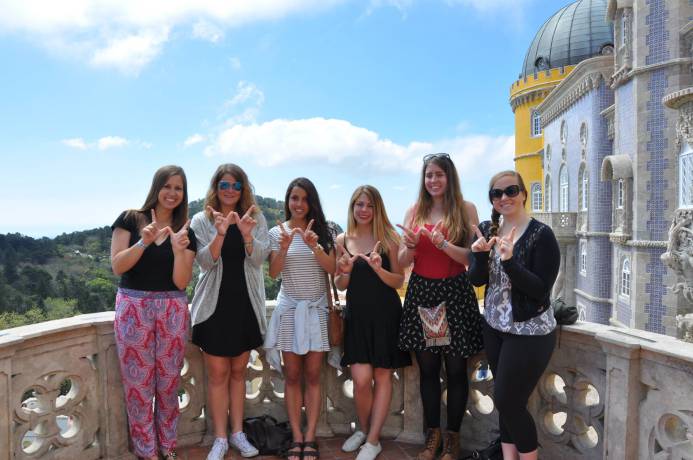Over the course of the semester, Sevilla y las Américas has met several times to learn more about Sevilla and its relationship with South American Spanish countries. Our first activity was taking a bike tour to see the Iberoamerican Exposition of 1929, where we saw the Plaza de España as well as the other pabellones that represented the cultures and country that either influenced Spain, or that Spain colonized. Way back after Cristobál Colón, or Christopher Columbus, discovered the Americas, Sevilla was known as an important city because it was the center of trade with the West. The boats arrived by the Guadalvivir River, so one of our activities was visiting the Sevilla Aquarium, which houses many species of fish from the river. The ships also sailed for the Americas from the port in Huelva, Spain, so we visited that city as well to learn more about the Columbus’s initial trip. The trip to Huelva was meant to be a beach day, so it was a bummer that it was rainy.


We left for Portugal early Friday morning, but since we drove with the wine interest group we didn’t make it to Lisbon until late Friday afternoon (they had to stop for a wine tasting). Fortunately, though, we were able to see the town of Évora, which contained ancient Roman ruins.


Lisbon, Portugal
I traveled to Lisbon with zero expectations and I am excited to say it has been my favorite city thus far. The city smelled like salt water, the sky was a deep ocean blue and the people there inspired a “chill” vibe.

One thing that stuck out to me during my visit was that the Portuguese have a competition of sorts with Spain. For example, the workers there preferred that we speak in English rather than Spanish, and one man even told two friends and myself that “Portuguese men are better looking,” and that Portugal actually founded the route to the Indias first. Even though Spanish culture wasn’t exactly the most welcome there, I did like that I could easily understand the gist of written Portuguese on signs since many Spanish and Portuguese words are similar.
I also enjoyed going on the trip with CIEE since we saw many places that I wouldn’t have made it to on my own. On Saturday, we climbed to the top of a small mountain to see a castle, Palacio de Pena, in Sintra. The Palacio used to be a monastery until the Great Lisbon Earthquake of 1755, which essentially destroyed all of Lisbon. To get up to the mountain we had to take narrow, winding roads in a huge bus. The bus driver seemed to have too much confidence when we were driving up and down the mountain, so the climb was a bit scary but exhilarating at the same time. The palace was built in the Romantic style, and has influences from the Renaissance, Gothic era and Islamic period. The colors are dynamic and playful so my friends and I thought we were in a Portuguese-Disney castle of sorts.

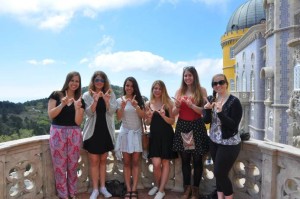


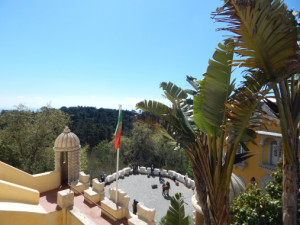
Later in the day we saw the Lisbon Exhibition of 1998, which is similar to the Sevilla Expo. The one in Lisbon is different since most of it is still standing and in use today, while the one in Sevilla wasn’t made for permanence.

Also, Lisbon has many similarities to San Francisco:
The Bay
San Francisco sits between a bay and an ocean, as does Lisbon.

The Red Bridge
Both cities have a similar red-orange, suspension bridge:
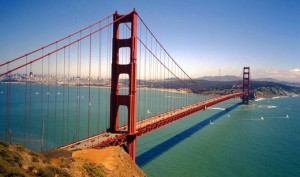

Tranvías
Historic cable and street cars run through both cities. In Lisbon, one of the lines is actually from Sevilla, and bears the NODO symbol that’s found throughout Sevilla.
Hills
As many girls from my generation know from the various scenes in The Princess Diaries, San Francisco is made up of seven hills. Our group quickly found this out after climbing the many hills while walking around Lisbon.
Earthquakes
Lisbon was hit by the 1755 earthquake, as I mentioned before, which was followed by a rampant fire and tsunami. The high death toll goes to show it was one of the deadliest earthquakes in Europe, and the city needed to be completely rebuilt afterwards. You can tell the city was rebuilt by looking at the street floors that make up the city, since the material comes from the rubble that was left over after the earthquake.
When you travel to a new city you absolutely need to try the traditional food there; CIEE treated us to customary Portuguese foods, liqueurs and pastries during our visit.



To finish up our trip, we visited el Castilo de Sao Jorge, the Torre de Belem, Padrao de Descobrimientos and the Cristo Rei. We took the Yellow Bus to a few places; it was a nice way to explore the city.
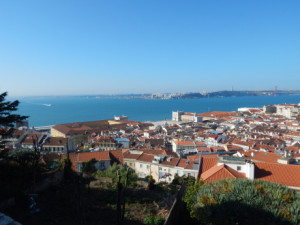


Finally, something I was excited to see due to my Catholic upbringing was the Cristo Rei, or a giant statue of Jesus Christ that overlooks Lisbon. It is 113 meters high and was designed by António Lino, although he died before it was completed. It was breathtaking to see.
I loved Portugal, and I hope to come back here again someday. This Thursday night I’m leaving on my last big trip while studying abroad: Two friends and I are going to Italy for a week! Stay tuned for the pasta, gelato and breathtaking (literally, breathtaking) hikes. 🙂

